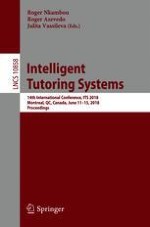2018 | Buch
Intelligent Tutoring Systems
14th International Conference, ITS 2018, Montreal, QC, Canada, June 11–15, 2018, Proceedings
herausgegeben von: Roger Nkambou, Dr. Roger Azevedo, Julita Vassileva
Verlag: Springer International Publishing
Buchreihe : Lecture Notes in Computer Science
